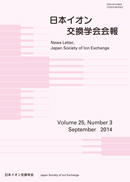All issues

Volume 25 (2014)
- Issue 4 Pages 65-
- Issue 3 Pages 37-
- Issue 2 Pages 17-
- Issue 1 Pages 1-
Volume 25, Issue 3
Displaying 1-3 of 3 articles from this issue
- |<
- <
- 1
- >
- >|
Award Paper
-
Nobuhiro KUMADA2014 Volume 25 Issue 3 Pages 37-44
Published: 2014
Released on J-STAGE: September 20, 2014
JOURNAL FREE ACCESSIon-exchange reaction with inorganic compounds was attempted to prepare new compounds and to adsorb anion or rare earth metal ions in solution. The Li+ ion in LiTaWO6 with the trirutile-type structure was ion-exchanged completely with proton to yield HTaWO6·nH2O. The protonated compounds, HTaWO6·nH2O had high selectivity for incorporation of Li+ ion and was strong brønsted acid. The Rb+ ion in Rb8Nb22O59 with a tunnel structure was ion-exchanged with proton and Na+ ion, and the Cs+ ion in Cs3Fe0.5Nb5.5O16 with a tunnel structure was replaced partially with Rb+ ion by immersing in molten salt. The pyrolysis products of Y2(OH)6−x(NO3)x·nH2O exhibited good performance of adsorption for Cl− ion in acidic solution. 13 inorganic compounds were attempted to adsorb rare earth metal ions in solution, and both of γ-ZrP and HAp had high ability for adsorption of rare earth metals in solution.
View full abstractDownload PDF (1319K)
Award Paper
-
Hitoshi MIMURA2014 Volume 25 Issue 3 Pages 45-51
Published: 2014
Released on J-STAGE: September 20, 2014
JOURNAL FREE ACCESSMassive tsunami caused by the Great East Japan Earthquake attacked the Fukushima Daiichi Nuclear Power Plant and caused the nuclear accident of level 7 to overturn the safety myth of nuclear power generation. The domestic worst accident does not yet reach the convergence, and many inhabitants around the power plant are forced to double pains of earthquake disaster and nuclear accident. At present, large amounts of high-activity-level water over 500,000 tons are stored in Fukushima NPP-1 site, which is a serious obstacle to take measures for the nuclear accident. For the decontamination of high-activity-level water containing seawater, the circulating injection cooling system using packed columns with inorganic ion-exchangers is operated and the cold shutdown is accomplished. However, the advancement of operating system and the safety management of secondary solid wastes are very important subject. In this paper, the adsorption properties and solidification characteristics are compared for Cs and Sr selective adsorbents mainly composed of zeolites and the enhancement of adsorption properties are reported. Especially, naturally occurring zeolites abundant in Japan have high selectivity towards Cs, and also have excellent functions of gas trapping and self sintering for stable solidification. Zeolites are thus expected for the treatment and disposal of contaminated water in future. This paper also reports the present situation of safety management of solid wastes and the development of stable solidification methods, and summarizes the future subjects considering the safety disposal.
View full abstractDownload PDF (1516K)
Award Paper
-
Takeshi HASHIMOTO2014 Volume 25 Issue 3 Pages 52-64
Published: 2014
Released on J-STAGE: September 20, 2014
JOURNAL FREE ACCESSSugars are essential biological molecules for metabolism, nutrition and cell structure, and they play vital roles in regulating birth, differentiation and immunity. Thus, it is important to develop methods for sugar sensing in aqueous solution. In this paper, the development of analytical reagent for sugar sensing based on esterization affinity of phenylboronic acids with cis-diol moiety in sugar molecule, has been reviewed by dividing into two design concepts of (1) metal-complex sensor in which phenylboronic acid was introduced to bis(β-diketonato)ruthenium complex and (2) phenylboronic-acid fluorescent probe and azoprobe complexes with cyclodextrin (CyD). Also, the design and evaluation of (3) selective sugar recognition by supramolecular CyD gel using soft molecular template effect and (4) azoprobe possessing multipoint binding sites for dopamine recognition, have been summarized.
View full abstractDownload PDF (1969K)
- |<
- <
- 1
- >
- >|